Search results for: 'paper ba'
- Related search terms
- paper bag
- paper bag]
- paper b
- Paper bag ma
- Paper Roll Making Machine
-
 YY-1357 HORIZONTAL CONTINUOUS FOAMING MACHINE, 21000 KG PER HOURYY-1357 HORIZONTAL CONTINUOUS FOAMING MACHINE, 21000 KG PER HOUR MAIN TECHNICAL SPECIFICATION: 1.TOTAL LENGTH: 35000mm × WIDTH 4500mm × HEIGHT 3000mm 2. FOAMING WIDTH 1000mm TO APPROXIMATELY 2300mm 3.FOAMING HEIGHT: 1200mm 4.FOAMING DENSITY: 8 KG PER m3 TO APPROXIMATELY 80 KG PER m3 5.FOAMING SPEED: 0 TO 6.8 METERS PER MINUTE 6.MAX TOTAL OUTPUT: 80 LITERS TO 350 LITERS PER MINUTE 7.MATERIAL SPRAYING METHOD: TROUGH 8.ALL KINDS OF VALVES, PIPES AND SPARE PARTS 9.THE MEMBRANE AUTOMATICALLY RECEIVES THE VOLUME INSTALLMENT (TO USE THE NEWEST INSTALLMENT, TO GUARANTEE THAT IT RECEIVES VOLUME SIDE PAPER SMOOTHLY); 10.USES ENVIRONMENTALLY-FRIENDLY EQUIPMENT TO PURIFY EXHAUST GAS, NO POLLUTION PRESENT 11. RESPONSIBLE FOR ELECTRICAL, MECHANICAL MAINTENANCE PERSONNEL TRAINING 12.THE BLOCK CUTTER MACHINE CUTS THE BUN LENGTH USING ROTARY ENCODER AND THICKNESS GAUGE TO SETUP AND CONTROL 13. MIXING HEAD FRAME PLUS OVERHAUL STAND, LADDER AND BARRICADE 14.MIXING HEAD IS GERMAN PRECISION TECHNOLOGY 15.FOAMING OVEN, DECLINING BOARD AND OVEN INNER CONVEYOR MACHINE PARTS 16. MIXING HEAD SIZE: Φ100mm 18.MIXING HEAD MOTOR: 30 KW 19.TOTAL POWER: ABOUT 80 KW Learn More
YY-1357 HORIZONTAL CONTINUOUS FOAMING MACHINE, 21000 KG PER HOURYY-1357 HORIZONTAL CONTINUOUS FOAMING MACHINE, 21000 KG PER HOUR MAIN TECHNICAL SPECIFICATION: 1.TOTAL LENGTH: 35000mm × WIDTH 4500mm × HEIGHT 3000mm 2. FOAMING WIDTH 1000mm TO APPROXIMATELY 2300mm 3.FOAMING HEIGHT: 1200mm 4.FOAMING DENSITY: 8 KG PER m3 TO APPROXIMATELY 80 KG PER m3 5.FOAMING SPEED: 0 TO 6.8 METERS PER MINUTE 6.MAX TOTAL OUTPUT: 80 LITERS TO 350 LITERS PER MINUTE 7.MATERIAL SPRAYING METHOD: TROUGH 8.ALL KINDS OF VALVES, PIPES AND SPARE PARTS 9.THE MEMBRANE AUTOMATICALLY RECEIVES THE VOLUME INSTALLMENT (TO USE THE NEWEST INSTALLMENT, TO GUARANTEE THAT IT RECEIVES VOLUME SIDE PAPER SMOOTHLY); 10.USES ENVIRONMENTALLY-FRIENDLY EQUIPMENT TO PURIFY EXHAUST GAS, NO POLLUTION PRESENT 11. RESPONSIBLE FOR ELECTRICAL, MECHANICAL MAINTENANCE PERSONNEL TRAINING 12.THE BLOCK CUTTER MACHINE CUTS THE BUN LENGTH USING ROTARY ENCODER AND THICKNESS GAUGE TO SETUP AND CONTROL 13. MIXING HEAD FRAME PLUS OVERHAUL STAND, LADDER AND BARRICADE 14.MIXING HEAD IS GERMAN PRECISION TECHNOLOGY 15.FOAMING OVEN, DECLINING BOARD AND OVEN INNER CONVEYOR MACHINE PARTS 16. MIXING HEAD SIZE: Φ100mm 18.MIXING HEAD MOTOR: 30 KW 19.TOTAL POWER: ABOUT 80 KW Learn More -
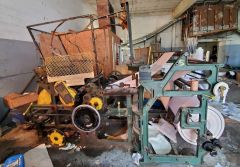 J-3534 POTDEVIN 104 BAG MAKING MACHINE, MULTIPLE SIZES POSSIBLEJ-3534 POTDEVIN 104 BAG MAKING MACHINE, MULTIPLE SIZES POSSIBLE STATUS: CURRENTLY RUNNING QUANTITY: 1 Learn More
J-3534 POTDEVIN 104 BAG MAKING MACHINE, MULTIPLE SIZES POSSIBLEJ-3534 POTDEVIN 104 BAG MAKING MACHINE, MULTIPLE SIZES POSSIBLE STATUS: CURRENTLY RUNNING QUANTITY: 1 Learn More -
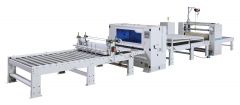 A-2502 PUR LAMINATING MACHINEA-2502 PUR LAMINATING MACHINE MODE SPECIFICATION: 240 X 1350 mm BOARD LENGTH: ANY MORE THAN 600 mm BOARD THICKNESS: 3 TO 50 mm BOARD WIDTH: 1220 mm OUTER DIMENSION OF MACHINE: 14100 X 2300 X 2500 mm RATE OF MATERIAL DELIVER: 1 TO 25 M/min GENERAL POWER: 46 KW TEMPERATURE MEASUREMENT SYSTEM: GERMANY IMPAC PRINCIPAL AXIS ROLLER DIAMETER: 320 mm MACHINE WEIGHT: 6000 KG PAPER WIDTH: 1280 mm Learn More
A-2502 PUR LAMINATING MACHINEA-2502 PUR LAMINATING MACHINE MODE SPECIFICATION: 240 X 1350 mm BOARD LENGTH: ANY MORE THAN 600 mm BOARD THICKNESS: 3 TO 50 mm BOARD WIDTH: 1220 mm OUTER DIMENSION OF MACHINE: 14100 X 2300 X 2500 mm RATE OF MATERIAL DELIVER: 1 TO 25 M/min GENERAL POWER: 46 KW TEMPERATURE MEASUREMENT SYSTEM: GERMANY IMPAC PRINCIPAL AXIS ROLLER DIAMETER: 320 mm MACHINE WEIGHT: 6000 KG PAPER WIDTH: 1280 mm Learn More -
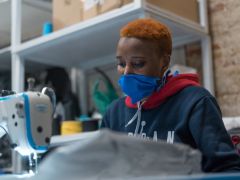 D-2388 What’s the Best Material for a Mask?
D-2388 What’s the Best Material for a Mask?Federal health officials have now recommended that we cover our faces with fabric during the coronavirus pandemic. But what material offers the most protection?
The Centers for Disease Control and Prevention has posted a no-sew mask pattern using a bandanna and a coffee filter as well as a video on making masks using rubber bands and folded fabrics found at home.
While a simple face covering can reduce the spread of coronavirus by blocking outgoing germs from coughs or sneezes of an infected person, experts say there is more variation in how much homemade masks might protect the wearer from incoming germs, depending on the fit and quality of the material used.
Scientists around the country have taken it upon themselves to identify everyday materials that do a better job of filtering microscopic particles. In recent tests, HEPA furnace filters scored well, as did vacuum cleaner bags, layers of 600-count pillowcases and fabric similar to flannel pajamas. Stacked coffee filters had medium scores. Scarves and bandanna material had the lowest scores, but still captured a small percentage of particles.
If you don’t have any of the materials that were tested, a simple light test can help you decide whether a fabric is a good candidate for a mask.
“Hold it up to a bright light,” said Dr. Scott Segal, chairman of anesthesiology at Wake Forest Baptist Health who recently studied homemade masks. “If light passes really easily through the fibers and you can almost see the fibers, it’s not a good fabric. If it’s a denser weave of thicker material and light doesn’t pass through it as much, that’s the material you want to use.”
Researchers say it’s important to remember that lab studies are conducted under perfect conditions with no leaks or gaps in the mask, but the test methods give us a way to compare materials. And while the degree of filtration for some homemade masks seems low, most of us — who are staying home and practicing social distancing in public — don’t need the high level of protection required for medical workers. More important, any face covering is better than none, especially if worn by a person who has the virus but doesn’t know it.
The biggest challenge of choosing a homemade mask material is to find a fabric that is dense enough to capture viral particles, but breathable enough that we can actually wear it. Some items being touted online promise high filtration scores, but the material would be unwearable.
Dressing Up for Work … at Home
Yang Wang, an assistant professor of environmental engineering at Missouri University of Science and Technology, worked with his graduate students to study various combinations of layered materials — including both air filters and fabric. “You need something that is efficient for removing particles, but you also need to breathe,” said Dr. Wang, who last fall won an international award for aerosol research.To test everyday materials, scientists are using methods similar to those used to test medical masks, which everybody agrees should be saved for medical workers who are exposed to high doses of virus from seeing infected patients. The best medical mask — called the N95 respirator — filters out at least 95 percent of particles as small as 0.3 microns. By comparison, a typical surgical mask — made using a rectangular piece of pleated fabric with elastic ear loops — has a filtration efficiency ranging from 60 to 80 percent.
Dr. Wang’s group tested two types of air filters. An allergy-reduction HVAC filter worked the best, capturing 89 percent of particles with one layer and 94 percent with two layers. A furnace filter captured 75 percent with two layers, but required six layers to achieve 95 percent. To find a filter similar to those tested, look for a minimum efficiency reporting value (MERV) rating of 12 or higher or a microparticle performance rating of 1900 or higher.
The problem with air filters is that they potentially could shed small fibers that would be risky to inhale. So if you want to use a filter, you need to sandwich the filter between two layers of cotton fabric. Dr. Wang said one of his grad students made his own mask by following the instructions in the C.D.C. video, but adding several layers of filter material inside a bandanna.
Dr. Wang’s group also found that when certain common fabrics were used, two layers offered far less protection than four layers. A 600 thread count pillow case captured just 22 percent of particles when doubled, but four layers captured nearly 60 percent. A thick woolen yarn scarf filtered 21 percent of particles in two layers, and 48.8 percent in four layers. A 100 percent cotton bandanna did the worst, capturing only 18.2 percent when doubled, and just 19.5 percent in four layers.
The group also tested Brew Rite and Natural Brew basket-style coffee filters, which, when stacked in three layers, showed 40 to 50 percent filtration efficiency — but they were less breathable than other options.
If you are lucky enough to know a quilter, ask them to make you a mask. Tests performed at the Wake Forest Institute for Regenerative Medicine in Winston-Salem, N.C., showed good results for homemade masks using quilting fabric. Dr. Segal, of Wake Forest Baptist Health, who led the study, noted that quilters tend to use high-quality, high-thread count cotton. The best homemade masks in his study were as good as surgical masks or slightly better, testing in the range of 70 to 79 percent filtration. Homemade masks that used flimsier fabric tested as low as 1 percent filtration, Dr. Segal said.
The best-performing designs were a mask constructed of two layers of high-quality, heavyweight “quilter’s cotton,” a two-layer mask made with thick batik fabric, and a double-layer mask with an inner layer of flannel and outer layer of cotton.
Bonnie Browning, executive show director for the American Quilter’s Society, said that quilters prefer tightly woven cottons and batik fabrics that stand up over time. Ms. Browning said most sewing machines can handle only two layers of fabric when making a pleated mask, but someone who wanted four layers of protection could wear two masks at a time.
Ms. Browning said she recently reached out to quilters on Facebook and heard from 71 people who have made a combined total of nearly 15,000 masks. “We quilters are very much in the thick of what’s going on with this,” said Ms. Browning, who lives in Paducah, Ky. “One thing most of us have is a stash of fabric.”
People who don’t sew could try a folded origami mask, created by Jiangmei Wu, assistant professor of interior design at Indiana University. Ms. Wu, who is known for her breathtaking folded artwork, said she began designing a folded mask out of a medical and building material called Tyvek, as well as vacuum bags, after her brother in Hong Kong, where mask wearing is common, suggested it. (DuPont, the maker of Tyvek, said in a statement that Tyvek is intended for medical apparel, not masks.) The folded mask pattern is free online, as is a video demonstrating the folding process. In tests at Missouri University and University of Virginia, scientists found that vacuum bags removed between 60 percent and 87 percent of particles. But some brands of vacuum bags may contain fiberglass or are harder to breathe through than other materials, and shouldn’t be used. Ms. Wu used a bag by EnviroCare Technologies, which has said it does not use fiberglass in its paper and synthetic cloth bags.
“I wanted to create an alternative for people who don’t sew,” said Ms. Wu, who said she is talking to various groups to find other materials that will be effective in a folded mask. “Given the shortage of all kinds of materials, even vacuum bags might run out.”
The scientists who conducted the tests used a standard of 0.3 microns because that is the measure used by the National Institute for Occupational Safety and Health for medical masks.
Linsey Marr, a Virginia Tech aerosol scientist and an expert in the transmission of viruses, said the certification method for respirators and HEPA filters focuses on 0.3 microns because particles around that size are the hardest to catch. While it seems counterintuitive, particles smaller than 0.1 microns are actually easier to catch because they have a lot of random motion that makes them bump into the filter fibers, she said.
“Even though coronavirus is around 0.1 microns, it floats around in a wide range of sizes, from around 0.2 to several hundred microns, because people shed the virus in respiratory fluid droplets that also contain lots of salts and proteins and other things,” said Dr. Marr. “Even if the water in the droplets fully evaporates, there’s still a lot of salt and proteins and other gunk that stays behind as solid or gel-like material. I think 0.3 microns is still useful for guidance because the minimum filtration efficiency will be somewhere around this size, and it’s what NIOSH uses.”
Learn More -
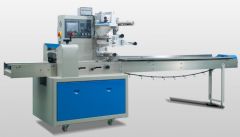 V-1806 HALF AUTOMATIC FACE MASK WITH INNER EAR LOOP PACKING MACHINE
V-1806 HALF AUTOMATIC FACE MASK WITH INNER EAR LOOP PACKING MACHINEI. FUNCTION
Learn More
THIS MACHINE IS USED TO PACK DISPOSABLE SURGICAL FACE MASK WITH THE SIZE OF 190 X 65mm. IT CAN ALSO BE USED TO PACK OTHER PRODUCTS SUCH AS WET TISSUE.
II. FEATURES:
1. ONE SET OF INK TO INJECT PRINTER IS INCLUDED; IT CAN BE USED TO PRINT THE DATA AND OTHER INFORMATION.
2. THE AIR COMPRESSOR EQUIPMENT IS OPTIONAL.
3. PACKING MATERIAL: SINGLE TO SIDE HEAT TO SEALING PACKAGING FILM MATERIALS, SUCH AS OPP, CPP, OPP COMPOSITE PE, PET COMPOSITE PE, SINGLE TO LAYER OR COMPOSITE PACKAGING FILM MATERIALS.
4. BAG FORM: BACK TO SEALED PACKING, CAN BE CUSTOMIZED.
5. VERTICAL/HORIZONTAL SEAL: RETICULATED PACKAGING/VERTICAL AND RETICULATED PACKAGING.
III. SPECIFICATION:
NAME: PILLOW PACKING MACHINE
TYPE KD TO 350
APPLICATION: FOR ALL KINDS OF OPP HEAT TO SEALING FILM, COMPOSITE FILM, SPRAY FILM PAPER, ALUMINUM FOIL FILM, ALUMINUM PLASTIC COMPOSITE FILM
MACHINE SIZE: 4600 X 850 X 1500
PACKING SPEED: 60 TO 220 BAG/MIN
MAX. PACKING SIZE: 330mm, 150mm, 80mm. LENGTH: 330mm, WIDTH: 150mm, HEIGHT: 80mm
MIN. PACKING SIZE: 50mm, 10mm, 5mm. LENGTH: 50mm, WIDTH: 10mm, HEIGHT: 5mm
ELECTRICAL: AC220V, 2.7KW
AIR PRESSURE 0.5 TO 0.7 MPA
AIR CONSUMPTION: >0.36 (M3/H)
(DB) NOISE: 60 TO 70DB
MACHINE WEIGHT: 550KG
MOTOR FREQUENCY ADJUST: 0 TO 50HZ
AUTOMATIC CONTROL
AUTOMATIC PRINTING
STANDARD: GMP STANDARD, PACKAGING MACHINE ENTERPRISE STANDARD
APPROVAL: ISO9001:2000, CE ISO:2000 -
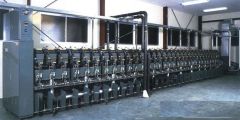 R-6443 YARN SINGEING MACHINE
R-6443 YARN SINGEING MACHINEYARN SINGEING MACHINE
Learn More
MODEL Q488
PRODUCT FEATURES:
FREQUENCY CONVERSION SPEED REGULATION DEVICE, CONVENIENT ADJUSTM
ENT WINDING LINEAR SPEED IS HIGH
TAPER TYPE CONE OR PLAIN CONE TYPE;
HIGH QUALITY OF METALLIC GROOVED DRUM THROUGH DYNAMICALLY BALANCED, GROOVED DRUM AXLE WITH HIGH
ACCURACY OF MANUFACTURE HAS PREMIX TYPE AIR/GAS MIXED BOX AND NEW TYPE BURNER, FLAME STABILIZATION, HIGH BURNING TEMPERATURE, EVEN
SINGEING, LOW GAS CONSUMPTION;
AUTOMATIC STOP MOTION
DUST BLOW-EXHAUST APPARATUS AND DUST REMOVAL BY VENTILATION DEVICE;
PLC CONTROL SYSTEM;
MAIN TECHNICAL PARAMETER:
EACH MACHINE HAS 72 SPINDLES (DOUBLE-FACED)
SPINDLE DISTANCE IS 288mm GAUGE, CAN BE PACKAGE, TAPER TUBE, PARALLEL TUBE;
TUBE SIZE, PAPER TUBE IS 3° 30
PLASTIC TUBE IS 5 ° 57′, WOODEN TUBE ISΦ 25.4 × 147.5 × Φ 8.4
GROOVE DRUM MATERIAL IS ALUMINIUM ALLOY
WINDING SPEED 200 TO 750mm, 200 TO 8200mm
MOTOR POWER 14.14KW
DIMENSIONS (LWH) 13117 × 1850 × 2840mm
MACHINE WEIGHT: 4550 KGS
QUANTITY: 1 -
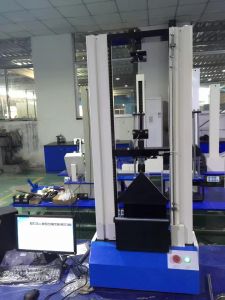 R-7121 TENSILE TESTER FOR PLASTIC FILMS, ADHESIVE TAPES, RUBBER, HARDNESS- BRAND NOVASTAR
R-7121 TENSILE TESTER FOR PLASTIC FILMS, ADHESIVE TAPES, RUBBER, HARDNESS- BRAND NOVASTARREFERENCE NUMBER: R-7121
SOFTWARE: TOUCH SCREEN AND COMPUTER OPERATED
CAPACITY: 5 kN
STANDARDS: ASTMD3575, ASTMD3574
SPEED UP TO 40 INCHES PER MININCLUDES:
Learn More
TEST A DENSITY TEST, 1% PRECISION, 200G (ELECTRIC BALANCE)
TEST D CONSTANT COMPRESSION TEST
QUANTITY: 1 -
 L-4214 HOT-MELT LAMINATION LINE, WIDTH 2600mm, 30 METERS PER MINUTE, YEAR 2007
L-4214 HOT-MELT LAMINATION LINE, WIDTH 2600mm, 30 METERS PER MINUTE, YEAR 2007REFERENCE NUMBER: L-4214
YEAR: 2007
PRODUCT WIDTIH: 2600mm
SPEED: 30 METERS PER MINUTE
BASIC WEIGHT: 50 TO 1,000 GRAMS PER SQUARE METER
OPERATING SIDE: LEFTQUANTITY: 1
Learn More -
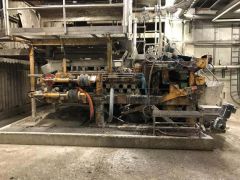 R-7245 ESCHER WYSS AND VOITH COMPLETE TISSUE MILL, YEAR 1988 OVERHAULED 1998 AND 2013
R-7245 ESCHER WYSS AND VOITH COMPLETE TISSUE MILL, YEAR 1988 OVERHAULED 1998 AND 2013REFERENCE NUMBER: R-7245
Learn More
EXCELLENT QUALITY 7.2M PAPER MACHINE
INSTALLATION BUILT BY: ESCHER WYSS AND VOITH
CAPACITY: 60 TO 80 TPD
VOITH AND ESCHER WYSS CAPACITY: 80 TPD
INSTALLED IN 1988 OVERHAULED 1998 AND 2013
MACHINE TYPE TWIN WIRE (TISCO FORMER)
YANKEE DIAMETER 3600V
SPEED MACHINE 1310 M/MIN
TABLE WIDTH 2690mm (AFTER REWINDER 2660mm)
QUANTITY: 1

